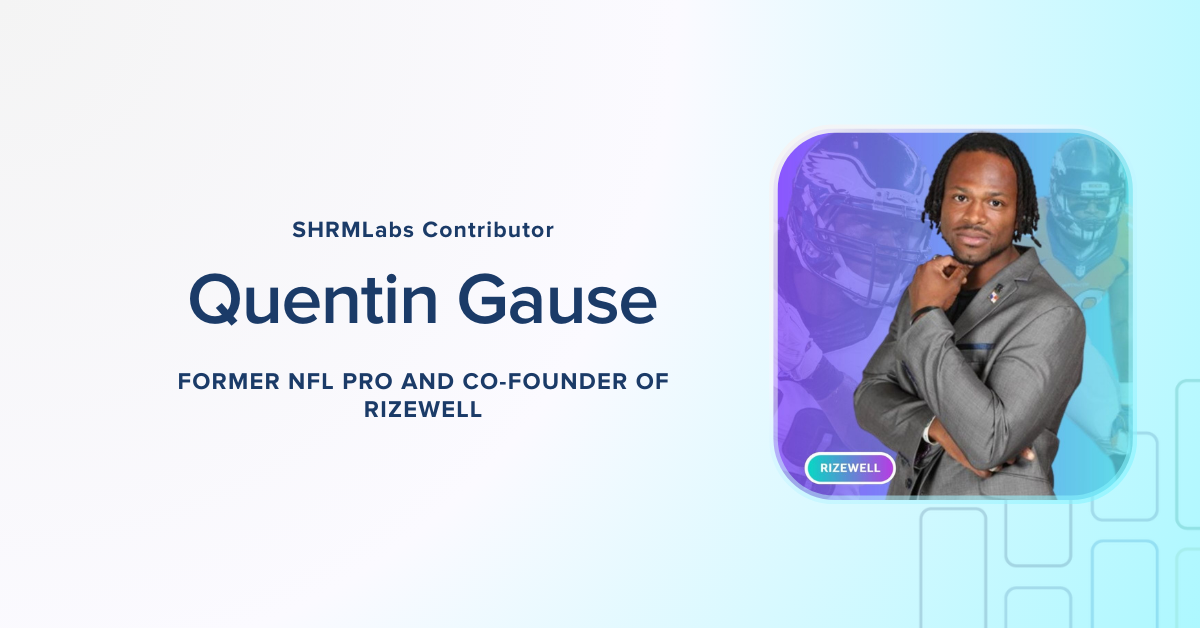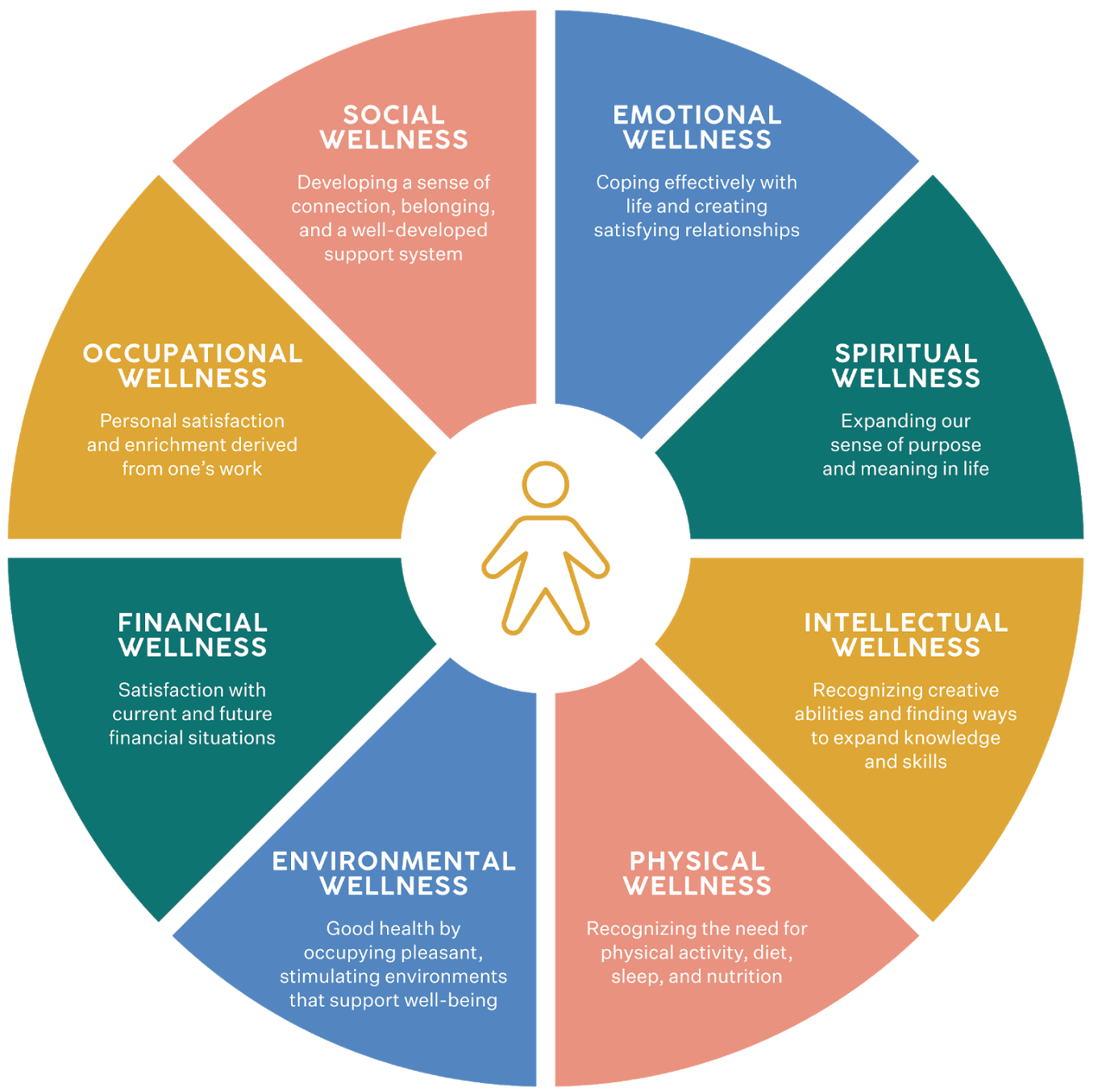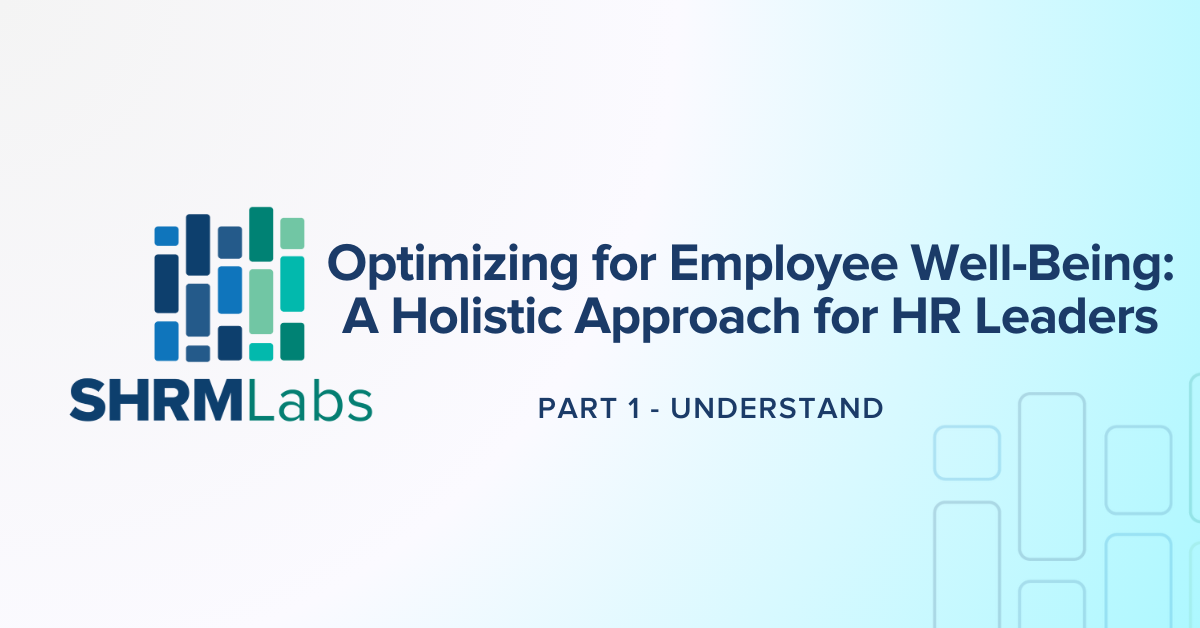Before we begin…
Welcome to the WorkplaceTech Pulse, presented by SHRM Labs. We are expanding our resources to bring you the best possible information from leaders in HR technology and transformation.
My name is Nell Hellem, innovation catalyst at SHRM Labs. You will hear from me as well as my colleagues every other week with the release of each new edition. Let us know any topics you’d like to hear about related to workplace tech and we will consider them for future editions of the WorkplaceTech Pulse.
Introduction
Employee well-being is a multifaceted concept that goes beyond physical health; it encapsulates mental, emotional and social aspects, each playing a crucial role in how employees engage with their work and the workplace. It's a holistic concept that includes:
Physical well-being: Ensuring employees are healthy and safe at work. It involves providing ergonomic workstations, promoting regular physical activity, and adhering to health and safety regulations.
Mental well-being: Mental well-being addresses the psychological aspects of employee health, including stress management, resilience building, and access to mental health support services. It emphasizes the importance of creating a supportive and inclusive work culture that values employees’ mental health.
Emotional well-being: Emotional well-being involves acknowledging and supporting employees’ emotions, providing them with the tools and resources to manage their feelings effectively. It involves fostering an environment where employees feel comfortable expressing their emotions and seeking help when needed.
Social well-being: Building a sense of community and belonging within the workplace. It involves promoting positive relationships among colleagues, encouraging teamwork, and creating opportunities for social interaction and collaboration.
This article is the first in a series of three on employee well-being in the workplace. In this first edition, we delve into the fundamentals of employee well-being, offering HR professionals a comprehensive understanding of this critical aspect of modern organizational life.
I’m excited to introduce this edition’s contributor, Quentin Gause. Quentin is a former NFL player with the Eagles, Patriots and Broncos who is now a tech innovator. After learning from some of the top doctors and wellness professionals in the world, he transitioned from the wellness field to the world of technology. His journey began with a keen observation of the challenges HR professionals face in enhancing employee well-being and engagement. Determined to make a difference, Quentin co-founded Rizewell to provide comprehensive AI-driven solutions that bridge the gap between wellness and technology. Quentin brings a unique perspective to Rizewell. His passion for empowering individuals to lead healthier lives, combined with a deep understanding of the corporate landscape, drives Rizewell’s mission. Quentin, over to you!

Thanks, Nell! Hi, I'm Quentin Gause, a former-NFL-player-turned-tech-entrepreneur with a fire for revolutionizing workplace wellness. My journey has taken me from the NFL, playing with the Eagles, Patriots and Broncos, to the heart of innovation in Atlanta. My rich Afro-Latino heritage, with roots stretching from Panama to Miami to Rochester, N.Y., has shaped my worldview and sparked my entrepreneurial spirit.
At Rizewell, which I co-founded, we’re on a mission to transform employee well-being. Drawing from a wealth of knowledge gained alongside some of the top health professionals, our team is pioneering artificial intelligence and virtual reality solutions to foster employee well-being and engagement for organizations worldwide. We’re proud to collaborate with leading names across various sectors, including tech giants such as Google and health organizations such as the Department of Health, to create healthier, more engaged workplaces.
I’m excited to lead this change with you. Now that you have gotten to know me, let’s dive in.
Employee Well-Being
This is part 1 of a 3-part series! Want to learn more about employee well-being?
- Part 1: Understand ← This edition!
- Part 2: Implement
- Part 3: Elevate
Be sure to check out all of our editions of the WorkplaceTech Pulse!
The Wellness Wheel: A Multidimensional Approach to Organizational Well-Being
The first step into understanding employee well-being as a whole for your organization is viewing it like a pie with eight important core pieces that all work in conjunction with one another. This pie is what we call the Wellness Wheel. The Wellness Wheel is a model that we use at Rizewell that serves as a beacon for comprehensive employee well-being. Each piece of the pie is going to be a bit different for every organization. Some companies may have a higher focus on social wellness, some may lock in on emotional wellness due to employee burnout and others may target the entire wheel. Some pieces might even be taken out of the pan. Regardless, these eight important pieces are what you need to look at when developing your employee well-being strategy because this all ties into the foundational culture of your organization.

Now, let’s dive into each one:
Social wellness is the linchpin that bolsters collaborative dynamics and community engagement. In contemporary organizational design, an emphasis on cultivating robust social networks within the corporate structure is paramount.
Emotional wellness transcends personal health, impacting organizational resilience and adaptability. Effective emotional stewardship within the workplace is critical for sustaining a productive and emotionally intelligent workforce.
Occupational wellness is not solely about job satisfaction; it is also about aligning individual purpose with professional endeavors. It is the responsibility of HR leaders to navigate this alignment through strategic role design and career development pathways.
Financial wellness is a potent undercurrent that influences employee stress levels and work satisfaction. HR’s role extends to providing employees with the resources needed to achieve financial security and literacy.
Environmental wellness exerts a profound influence on employee well-being and productivity. HR’s role is to create a physical and aesthetic workspace that not only adheres to safety standards but also promotes environmental consciousness and well-being.
Physical wellness remains a cornerstone of employee health initiatives. Comprehensive health programs are essential to maintaining a workforce capable of meeting the demands of a competitive business environment.
Intellectual wellness urges continuous learning and mental growth. It’s a catalyst for innovation and engagement. A workplace that values and promotes intellectual growth fosters a dynamic and competitive edge.
Spiritual wellness, though less tangible, is intrinsic to individual and corporate harmony. It is incumbent upon HR to respect and accommodate the diverse spiritual needs of the workforce.
Each of these eight dimensions, while distinct, does not exist in isolation. Like the spokes of a wheel, they support and reinforce each other, promoting a robust structure that can withstand the bumps and turns on the road of life.
The Role of HR in Employee Well-Being
In this intricate dance of well-being, HR professionals play the pivotal role of choreographers, carefully orchestrating programs and initiatives that resonate with each unique individual in their organization and their culture. They act as the guardians of this wheel, ensuring that it turns smoothly and that each employee’s journey toward wellness is met with understanding, support and the resources needed to succeed.
Standing at the forefront of shaping and sustaining the workplace environment, HR professionals effectively act as the architects of employee well-being. Their role transcends traditional administrative functions to encompass the creation of a supportive and healthy work culture. This pivotal position allows HR to influence not just the physical but also the psychological and emotional health of the workforce.
Understanding HR’s Responsibility
The responsibility of HR in this realm is twofold: to advocate for employee well-being at the strategic level and to implement practical solutions that make a real difference in the day-to-day lives of employees. This involves:
Strategic advocacy: Elevating employee well-being as a key factor in organizational strategy and decision-making processes. HR must make the case for well-being initiatives not just as the right thing to do, but as a strategic imperative that drives retention, engagement and performance.
Practical implementation: Developing and deploying programs and policies that directly impact employee well-being. This includes health and wellness programs, flexible work arrangements, mental health days, and initiatives that foster a supportive work culture.
Building the Foundations of Well-Being
The foundations of a well-being-focused workplace are built on a deep understanding of employee needs and a commitment to addressing them. HR professionals must engage in active listening by leveraging surveys, feedback mechanisms and direct communication to gather insights into what employees truly value and need. This data-driven approach ensures that initiatives are not just well intentioned but are also aligned with the actual requirements of the workforce.
Addressing the Real Concerns of Employees
With SHRM Research highlighting "insufficient regard for employee well-being" as a key factor driving high-value employees away, the message is clear: Employees are increasingly prioritizing workplaces that care about their holistic well-being. This sentiment underscores the responsibility of HR to not only understand but also genuinely address the well-being concerns of their employees. It involves recognizing the multifaceted nature of well-being that includes mental health support, physical health resources, career development opportunities, and a culture of inclusivity and respect.
Tools for Building a Culture of Well-Being
To effectively foster a culture of well-being, HR professionals need a toolkit that combines strategic insights with practical applications. This toolkit should include:
Analytical tools: To gather and analyze data on employee needs, satisfaction and feedback. This could involve survey platforms, sentiment analysis tools and HR analytics software.
Communication platforms: For transparent and ongoing communication with employees about well-being initiatives, resources and feedback channels.
Well-being programs: A range of programs that cater to different aspects of well-being, including physical health programs, mental health support, financial wellness advice and career development pathways.
Training and development: Resources to train leaders and managers on the importance of well-being, how to recognize signs of stress or burnout in their teams, and how to foster a supportive team environment.
Feedback mechanisms: Systems for collecting and responding to employee feedback on well-being initiatives, ensuring that programs evolve in line with employee needs.
Assessing the Current State of Well-Being
Creating impactful well-being strategies necessitates a deep dive into the current state of employee wellness within your organization. This process is fundamental not just for identifying current issues but also for aligning your strategies with broader organizational goals. By engaging main leaders and stakeholders early in the process, you establish a unified approach that significantly enhances how employee needs are addressed alongside organizational objectives. This collaborative effort fosters a culture of understanding and support that is essential for the successful implementation of well-being programs.
Conducting Surveys and Gathering Feedback
One of the most effective ways to gauge the well-being of your workforce is by conducting comprehensive surveys and actively seeking employee feedback. These surveys should cover a range of topics, including employee satisfaction, stress levels, mental health, physical health and overall well-being. The design of these surveys is crucial: They should be anonymous to encourage honesty, as well as comprehensive to ensure all areas of well-being are covered. This direct line of communication enables employees to express their needs and concerns, providing valuable insights into the collective health of your organization.
Analyzing the Data
The data gathered from these surveys is a gold mine of information that, when properly analyzed, can highlight critical areas requiring attention. It’s essential to go beyond mere numerical analysis to interpret these results in a way that uncovers common themes, recurring issues and potential areas for improvement. Despite the importance of this analysis, a startlingly low percentage of organizations—only 17%, as reported by HR professionals in 2022—actively measure the effectiveness of their mental health and well-being programs1. This gap in assessment underscores the need for a more structured approach to evaluating well-being initiatives.
By carefully analyzing survey data, organizations can:
Identify key stressors: Understand the primary sources of stress and dissatisfaction within the workforce. This could range from workload and work/life balance to relationships with management and career development opportunities.
Gauge program effectiveness: Evaluate how existing well-being and mental health programs are perceived by employees. Are these initiatives accessible, effective and valued by the workforce?
Tailor interventions: Customize well-being initiatives to address specific needs identified through the surveys. This could mean introducing new mental health resources, adjusting workloads or offering more flexible working arrangements.
Set benchmarks for improvement: Establish clear benchmarks based on survey results to measure the impact of implemented changes over time. This allows for continuous improvement and ensures that well-being strategies remain aligned with employee needs.
Moving Forward
Understanding employee well-being and its current state within your organization is just the first step in the larger journey toward building a comprehensive employee well-being strategy. This initial assessment lays the groundwork for developing targeted interventions that can significantly enhance life at work for your employees.
Now, as we move to Part 2 of our series, we anticipate delving into the practical application of these insights. The upcoming edition will pivot from understanding to action, focusing on the tangible steps required to actualize a robust employee well-being strategy. We will explore how to effectively implement wellness programs, engage in meaningful change management and harness the power of AI and other technology to support our goals. See you in Part 2!
References and Further Reading
- https://www2.deloitte.com/us/en/insights/focus/human-capital-trends/2023/future-of-workforce-management.html
- https://forbes.com/sites/work-in-progress/2013/06/11/challenge-2013-linking-employee-wellness-morale-and-the-bottom-line/?sh=7246bff45ca2
- https://www.cdc.gov/chronicdisease/about/costs/index.htm
- https://www.cooleaf.com/blog/workplace-wellness-trends-for-2023
- https://www.shrm.org/topics-tools/news/global-culture-2023#
Thanks for joining us for this edition of the SHRM Labs WorkplaceTech Pulse! Thanks again to Quentin Gause for his incredible insight on the topic of employee well-being. Please click the link below to learn more about Rizewell and the great work it’s doing around employee well-being. We’ll see you next time!

SHRM Labs, powered by SHRM, is inspiring innovation to create better workplace technologies that solve today’s most pressing workplace challenges. We are SHRM’s workplace innovation and venture capital arm. We are Leaders, Innovators, Strategic Partners, and Investors that create better workplaces and solve challenges related to the future of work. We put the power of SHRM behind the next generation of workplace technology.





